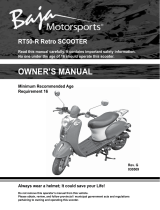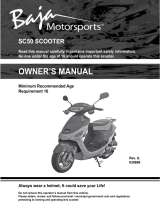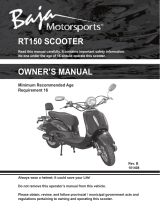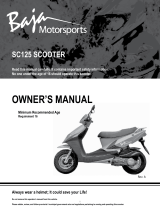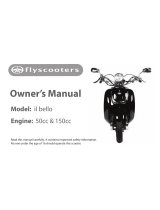Page is loading ...

SC150 SCOOTER
Read this manual carefully. It contains important safety information.
No one under the age of 16 should operate this scooter.
Always wear a helmet; It could save your Life!
Do not remove this operator’s manual from this vehicle.
Please obtain, review, and follow provincial / municipal government acts and
regulations pertaining to owning and operating this scooter.
OWNER’S MANUAL
Minimum Recommended Age
Requirement 16
Rev. E
030909

II
Congratulations on your purchase of the BAJA INC. SC150 Scooter.
Your Scooter is warranted to be free of manufacturing defects in
material and workmanship for a period of 90 days from the date of
purchase. During the warranty period BAJA INC. will at its option,
repair, provide replacement parts or replace your BAJA INC. 150cc
Scooter at no charge. This warranty does not cover normal wear
items or damage caused by neglect or misuse of the product.
Engine Warranty – 90 days
Frame Warranty – 90 days
Warranty is void if:
Frame is bent or broken due to abuse
Wheels are bent or broken
Fender bent or broken due to abuse
Any sign of impact, accident, jumping, spin-outs or roll over.
BAJA INC. is not liable for any damage claim or liability claim person
or otherwise resulting from the operation of this product in any way.
Should you experience a problem with your vehicle, please call the Baja
INC. customer service line toll free at 1-888-863-2252 between the hours of
7am and 5pm Monday through Friday MST (Mountain Standard Time). MDT
(Mountain Daylight Time) during daylight saving time. You will be instructed
how to proceed.
A COPY OF THE SALES RECEIPT IS REQUIRED.

III
This manual should be considered as a permanent part
of the vehicle and should remain with the vehicle when
resold or otherwise transferred to a new user or operator.
The manual contains important safety information and
instructions which should be read carefully before
operating the vehicle. All operators should obtain, review,
and follow provincial and municipal government acts and
regulations pertaining to owning and operating an
on-road vehicle. Children under the age of 16 should
never operate this vehicle.
WARNING
It is the operators responsibility to know and obey all
applicable local, state and federal laws at all times while
operating this vehicle including but not limited to trafc
safety, vehicle registration, emissions, and noise
WARNING
!
The engine exhaust from this product contains chemicals
known to the State of California to cause cancer, birth
defects or other reproductive harm.
CALIFORNIA PROPOSITION 65
WARNING
!
!

1
IMPORTANT ........................................................................................................ 2
GENERAL PRECAUTIONS/WARNINGS ............................................................ 3
NHTSA SAFETY NOTICE .................................................................................... 8
PRE RIDE CHECK LIST ...................................................................................... 9
LOCATION OF WARNING LABELS................................................................... 12
OPERATION ........................................................................................................ 13
STARTING THE ENGINE ............................................................................. 13
DRIVING SAFELY ........................................................................................ 14
SHUTTING OFF THE ENGINE .................................................................... 15
STOPPING THE VEHICLE .......................................................................... 15
PARKING ..................................................................................................... 15
BREAKING IN .............................................................................................. 15
IGNITION SWITCH ...................................................................................... 16
BRAKE LEVERS AND THROTTLE ............................................................. 16
RIGHT BRAKE/SWITCH ASSEMBLY ......................................................... 17
KICK STARTER ........................................................................................... 18
LEFT BRAKE/SWITCH ASSEMBLY ........................................................... 18
INSTRUMENT PANEL ................................................................................. 19
CLOCK/CALENDAR ADJUSTMENT .......................................................... 19
SEAT LOCK ................................................................................................. 20
FUEL TANK .................................................................................................. 20
BATTERY INSTALLATION .................................................................................. 21
MAINTENANCE ................................................................................................... 24
SPARK PLUG .............................................................................................. 24
TRANSMISSION OIL ................................................................................... 24
ENGINE OIL ................................................................................................. 25
CHANGING ENGINE OIL, CLEANING OIL SCREEN ................................. 26
BRAKES ...................................................................................................... 27
AIR FILTER .................................................................................................. 28
IDLE SPEED ADJUSTMENT/FUEL HOSE INSP. ....................................... 29
TIRES ........................................................................................................... 30
TRANSPORTING ................................................................................................. 31
STORAGE PROCEDURE .................................................................................... 32
MAINTENANCE CHART ..................................................................................... 33
TROUBLESHOOTING ......................................................................................... 34
SPECIFICATIONS ................................................................................................ 36
ELECTRIC DIAGRAM ......................................................................................... 37
SERIAL NUMBER LOCATION ............................................................................ 38
EMISSION CONTROL SYSTEM WARRANTY .................................................... 39
Table of Contents

2
Please read this manual and follow all instructions carefully. To emphasize
the special information, the symbol and the words WARNING or CAUTION
have some special meanings. Pay attention to the messages.
NOTE: Indicating special information which is to make maintenance easier or
instructions clearer.
WARNING and CAUTION are arranged like this:
This user’s manual contains important safety and maintenance information.
Read it carefully before riding. Failing to follow the warnings contained in this
manual could result in INJURY or DEATH.
It is important that this manual remain with the vehicle when you transfer it to
another user or owner.
All information, illustrations, photographs and specications contained in
this manual are based on the latest product information available at the time
of publication. Due to improvements or other changes, there will be some
discrepancies in this manual. We reserve the right to make product changes
at any time, without notice and without incurring any obligation to make the
same or similar changes to the vehicle previously built or sold.
WARNING-or-CAUTION
The rst part will identify a POTENTIAL HAZARD.
The second part will describe WHAT COULD HAPPEN if you ignore
the WARNING or CAUTION.
The third part will describe HOW TO AVOID THE HAZARD.
CAUTION
Indicates a potential hazard that could result in vehicle damage.
WARNING
Indicates a potential hazard that could result in death or injury.

3
.
● Read and follow all instructions in this Owner’s/Operator’s Manual,
any accompanying supplements. Do not discard this owner’s
manual, safety video, or any other material or documentation
included with this vehicle.
● Exhaust fumes are toxic. California Proposition 65 warning:
Gasoline engine exhaust from this vehicle contains chemicals known
to the State of California to cause cancer, birth defects, or other
reproductive harm. The engine exhaust contains carbon
monoxide, which is tasteless, odorless, poisonous gas. Never
operate this vehicle indoors or in an enclosed area with poor
ventilation.
● This vehicle may have been supplied to you completely assembled.
To prevent possible injury or death, read and follow the assembly
instructions to make sure the vehicle was assembled properly.
● Always perform the daily pre-ride inspection specied in this manual
before operating this vehicle.
● Modifying the vehicle and/or removing original equipment and/or
safety decals could make this vehicle unsafe for operation.
● Replace any safety decals that become unreadable or detached from
the vehicle. Decals provide critical warnings about potential hazards
or safety requirements.
● Never use this vehicle for stunt riding, spin-outs, donuts, racing , or
any form of competition.
WARNING! FAILURE TO FOLLOW THESE INSTRUCTIONS CAN
RESULT IN SEVERE INJURY OR DEATH.
CAUTION: FAILURE TO FOLLOW THESE INSTRUCTIONS CAN
ALSO RESULT IN DAMAGE TO THE VEHICLE AND/OR OTHER
PROPERTY.
General Precautions
!

4
Additional Warnings
Protective Clothing/Equipment
● Most accident fatalities are due to preventable head injuries. Always
wear a properly tting motorcycle type helmet approved by agencies
such as the Department of Transportation (DOT), Safety Helmet
Council of America (SHCA), or Snell Memorial Foundation (SNELL).
● Always wear face shields or goggles, boots, gloves and other
appropriate protective clothing.
● Long hair, loose clothes, or jewelry can get caught in moving parts
below and behind the seat or your surrounding environment.
Remove or tie back anything loose that can reach below and behind
the seat before riding.
Moving Parts
● Never place hands, feet, any body parts or clothing near the engine,
wheels, chain and other rotating parts of the vehicle while riding or
running the engine.
● Use extreme caution when performing required maintenance while
the engine is running.
● Keep guards and pads in place at all times. Prevent accidental
contact by any person whenever the vehicle is running.
● The guards over the brake, clutch, torque-converter, axle and drive
sprockets also help prevent mud and debris from contacting those
components.
Trafc Safety
● ALWAYS FOLLOW THE ENTIRE PRE-RIDE CHECKLIST PRIOR TO
STARTING OR RIDING THE SCOOTER.
● Your safety while riding this vehicle depends entirely on your ability
to exercise proper judgement. You must be of sufcient age,
understanding, mental capacity, and physical capability to safely
operate this vehicle.

5
Additional Warnings (continued)
Traffic Safety (continued)
● Always obtain mature, supervised instruction and sufcient practice
in an decongested area before operating this vehicle on any public
thoroughfare.
● Excessive vehicle speed is a leading cause of accidents, which can
cause death or serious harm to you, other people, and/or property.
Always obey all applicable trafc safety laws while operating this
vehicle, being sure to account for current weather and trafc
conditions and slow down if necessary. DRIVE TO ARRIVE!
● Use extreme caution when riding on wet, slippery, rough or slopped
terrain. There is an increased risk of loss of control, which can result
in injury, death, and/or property damage.
● Always slow down when turning. High-speed turning can cause loss
of control and/or possible death, injury, and/or property damage.
Practice turning in a safe area away from trafc until you are
condent in your ability to control the vehicle at all times.
● Operating this vehicle at an unsafe speed, especially while turning,
can cause death, injury, and/or property damage.
● Never use this vehicle to perform any type of racing, stunt riding,
jumps, spin-outs, donuts, or other maneuvers, You could kill or
injure yourself or others and/or cause property damage.
● Never operate vehicle while under the inuence of alcohol, drugs or
medication of any kind. Such operation is dangerous to yourself
and/or others.
● Check the tire pressure before operating the vehicle using a properly
calibrated tire air pressure gauge.
● Stop the vehicle and shut off the engine immediately if the vehicle
makes unusual noises or vibrations. Check the vehicle for damage.
Excessive noise or vibration is a sign of loose or worn parts.

6
Additional Warnings (continued)
Engine/Motor Safety
● Keep the engine/motor free of dirt and debris, especially in the
throttle linkage area.
● Never start the engine/motor without checking to see that the throttle
control is in the idle position.
● Never start the engine/motor unless you are properly seated with
your hands rmly on the controls.
● Never tamper with, alter, or change the vehicle’s engine/motor
settings. The engine/motor governor is factory set and protects
the engine/motor from damage. Excessive engine/motor speed is
potentially dangerous to the operator, bystanders, and the
engine/motor itself.
● All guards must be in place prior to starting the engine.
● Operating the vehicle in conditions where water, mud, snow, dirt,
sand or other debris can get into the throttle cable conduit and/or the
throttle mechanism can cause the cable or throttle mechanism to
bind, which may lead to throttle sticking, loss of control, and
possible death, injury, and/or property damage.
Fasteners
● Make sure that all screws, nuts, and bolts are properly tightened.
Never over-tighten hardware that is designed to move, such as front
and rear wheels. Restricting moving parts can cause a loss of
control and possible injury or death.
● Always replace torque-type locknuts with new locknuts of the same
type after removing the old locknuts.
Fueling
● Check the fuel supply before each use. Never ll the fuel tank while
the engine is running or hot. Always allow at least 1in. of expansion
space at the top of the fuel tank. There should not be any fuel in the
ller neck. Replace the fuel cap tightly after refueling to prevent a
fuel spillage, re, or explosion hazard.

7
Additional Warnings (continued)
Fueling (continued)
● Always use an original gas cap or an approved OEM replacement.
Never ll fuel tank while the vehicle is inside a building. Gasoline
vapors can cause injury or death and can pose a re or explosion
risk.
● Move the vehicle at least 10 ft. before starting the engine.
● Use extreme caution when starting the engine. Hot engine, mufer,
or drive components can cause serious burns on contact.
Maintenance
● Do not modify the vehicle from the manufacturer’s original design
and conguration.
● Never wash or operate the vehicle in freezing temperatures. Water
can freeze in the throttle cable conduit and/or on the throttle
mechanism, possibly resulting in throttle sticking, which can cause
the engine to continue to run and result in loss of control.
● Assembly, maintenance, and/or repair of this vehicle should only be
performed by designated dealers or authorized repair centers to
ensure quality work and safe vehicle condition.
● Always disconnect the spark plug wire (gasoline vehicles) or
disconnect the battery before commencing any work in the engine
vicinity or where there is a possibility that the vehicle could move
unexpectedly. Keep the spark plug cable away from the spark plug to
avoid accidental starting.
● Avoid contacting the mufer, cylinder head, or any potentially hot
area on or around the engine when working on, around, or restarting
the engine.

8
Additional Warnings (continued)
Maintenance (continued)
● Store this vehicle in a place where gasoline fumes cannot reach an
open ame, spark, or other source of ignition. Drain the fuel tank
in a cool well-ventilated area prior to any long-term storage. Never
store this vehicle in a close proximity to appliances such as water
heaters or furnaces.
● Engine, exhausts, and other components can become extremely hot
during operation. Use caution when near hot components.
● Never adjust, repair, or clean the vehicle while it is in motion.
NHTSA Safety Notice
If you believe that your vehicle has a defect which could cause serious injury
or death, you should immediately contact the National Highway Traffic Safety
Administration (NHTSA) in addition to notifying BAJA INC.
If NHTSA receives similar complaints, it may open an investigation and if it
finds that a safety defect exists in a group of vehicles, it may order a recall
and remedy campaign.
However, NHTSA cannot become involved in any individual problems between
you, your dealer or BAJA INC.
To contact NHTSA you may call the Auto Safety Hot line toll-free within the
United States on 1-800-424-9393 or write to: NHTSA, 400 Seventh Street SW,
Washington, DC 20590.

9
Pre-Ride Checklist
WARNING! ALWAYS PERFORM THE ENTIRE PRE-RIDE
CHECKLIST BEFORE USING THE VEHICLE AS THIS CAN HELP
YOU SPOT PROBLEMS THAT COULD INTERFERE WITH SAFE
VEHICLE OPERATION. FAILURE TO FOLLOW THIS ENTIRE
CHECKLIST BEFORE EVERY RIDE CAN CAUSE DEATH,
SERIOUS INJURY, AND/OR PROPERTY DAMAGE TO YOURSELF
AND/OR OTHERS
SEAT LOCK
KICK START
LEVER
GAS CAP
LOCATED
UNDER SEAT
BATTERY
COMPARTMENT
LOCATED UNDER
FLOORBOARD
TAIL LIGHT
HEADLIGHTS
FRONT TURN SIGNALS
REAR
TURN
SIGNAL
CENTER
STAND
THROTTLE
GRIP
REAR BRAKE
LEVER
SIDE STAND
FRONT BRAKE
LEVER
AIR FILTER
LOCATED
UNDER SEAT
CARBURETOR
!
IGNITION KEY
SWITCH

10
Pre-Ride Checklist (continued)
Before Starting the Engine/Motor
1. Engine oil level
a) Check for leaks
b) Tighten filler cap securely.
c) Add oil if required.
2. Fuel level
a) Add fuel as necessary.
b) Do not overfill (no fuel in the filler neck).
c) Do not mix oil with gas.
d) Replace cap tightly.
e) Do not refuel a hot engine. Allow engine to cool before adding
fuel.
3. Warning decals
a) Make sure all warning decals are legible and securely attached.
b) Replace as necessary.
4. Tires
a) Ensure that both tires have at least 1/8 in. tread depth at center.
b) Both tires must be inflated to the pressure indicated on the tire
sidewalls.
c) Replace the tires id tread height is less then 1/8 in. at the center of
tires.
5. Throttle
a) Check for smooth operation. Make sure the throttle “snaps” back
to idle position when released.
b) Check for frayed cable or damaged cable housing. Replace
damaged cable.
c) Check for mud, debris and ice in the throttle cable/mechanism.
Clean out any contamination.

11
Pre-Ride Checklist (continued)
Before Starting the Engine/Motor
6. Fasteners
a) Check that axle nuts are secure.
b) Check for missing fasteners. Replace as necessary.
c) Check that all other fasteners are secure. Tighten as necessary.
7. Steering
Make sure steering turns freely.
8. Frame/chassis
Check for bent/damaged frame/chassis components. Replace as
necessary.
9. Battery (if equipped)
Check to make sure connections are tight and corrosion-free.
Clean/tighten as necessary.
10. Lights (if equipped)
Check for proper operation. Replace bulbs as necessary.

12
Read and follow the warning label on your Scooter. Make sure you
understand the label. Keep the label on the Scooter. Do not remove it for any
reason. If the label comes off or becomes difcult to read, you should get a
replacement by contacting BAJA INC.
Location of Warning Label
WARNING
!
Read and understand owners
manual before operating this
scooter.
Always wear a helmet, eye
protection and protective
clothing.

13
1
2
Operation
Starting the Engine
WARNING! ALWAYS RETRACT THE SIDE STAND PRIOR TO
STARTING THE VEHICLE
ATTENTION! SIDE KICK STAND (2) MUST BE PLACED IN
THE UP POSITION IN ORDER FOR ENGINE TO START.
If the engine is cold:
Balance the scooter on its center stand (1) with the side stand (2) fully
retracted. Make sure the ignition key is OFF, then rotate the throttle 5-8 times
to prime the engine. Squeeze the rear brake lever, turn the key to RUN, and
push the START button. Your scooter includes an automatic choke.
CAUTION: DO NOT RUN THE STARTER FOR MORE THAN 5
SECONDS AT A TIME. ALWAYS ALLOW AT LEAST 10 SECONDS
BETWEEN STARTING ATTEMPTS.
If the engine is warm:
Balance the scooter on its center stand (1) with the side stand (2) fully
retracted. Squeeze the rear brake lever, turn the key to RUN, and push the
START button. If the engine does not start after 5 seconds. wait 10 seconds,
then turn the throttle 1/3 turn while pressing the START button. This will over-
ride the automatic choke and help start the engine.
CAUTION: DO NOT RUN THE STARTER FOR MORE THAN 5
SECONDS AT A TIME. ALWAYS ALLOW AT LEAST 10 SECONDS
BETWEEN STARTING ATTEMPTS.
!
!

14
Operation (continued)
Driving Safely
WARNING! FOLLOW ALL OF THE WARNINGS IN THIS
OPERATOR’S MANUAL AT ALL TIMES WHILE OPERATING
THE SCOOTER. IT IS YOUR RESPONSIBILITY TO KNOW
AND OBEY ALL APPLICABLE LOCAL, STATE, AND
FEDERAL LAWS.
WARNING! NEVER OVERLOAD THE VEHICLE. THE
CARRYING CAPACITY IS 350 POUNDS.
After starting the engine, hold rear (left) brake lever and gently push the
scooter forward off the center stand.
Straddle the seat while keeping one foot on the ground for stability. Slowly
turn the throttle to begin driving. Place your foot on the floorboard as the
scooter begins moving.
Never attach any articles to the handlebar. Stow any cargo on the luggage
rack or in the under-seat storage box. Do not carry cargo weighing more than
10 pounds on the luggage rack. Always hold the rear hand hold when lifting
the scooter.
WARNING! ALWAYS WEAR A DOT-APPROVED HELMET,
EYE PROTECTION, AND SHOES WHEN RIDING YOUR
VEHICLE.
WARNING! NEVER DRIVE THE SCOOTER WITH THE SIDE
STAND EXTENDED.
NOTE: ENGINE WILL NOT START WITH SIDE STAND
EXTENDED
!
!
!
!

15
Operation (continued)
Shutting off the engine
Always shut off the engine by turning the ignition switch to OFF.
Stopping the vehicle
WARNING! WET, OIL, OR SANDY ROADS REDUCE
BRAKING EFFECTIVENESS. HARD BRAKING ON THESE
SURFACES COULD LEAD TO LOSS OF CONTROL AND A
SERIOUS ACCIDENT. ALWAYS REDUCE SPEED AS
GRADUALLY AS POSSIBLE.
When braking, always engage the rear brake first to retain maximum control
of the scooter. Most of your stopping power comes from the front wheel.
Parking
Always leave the ignition key in the lock position when parking the vehicle
to help prevent theft. Park on smooth hard surfaces, use the center stand
whenever possible.
Breaking in
● Following this break-in procedure ensures that your scooter is
functioning properly and maximizes engine life.
● Never drive this vehicle over 40mph during the first 250 miles of
operation. Excessive speed could result in engine failure.
● Always use fresh 89 octane gasoline. Avoid gasoline that contains
alcohol, which can damage rubber gaskets and engine seals.
● Check and adjust the brakes, throttle cable, tire pressure, and
fasteners weekly before riding. This is in addition to the pre-ride
inspection.
● Schedule regular maintenance with your authorized BAJA INC.
service center.
● Never add oil to the gasoline; your scooter has a 4-stroke engine
with an internal lubricating system.
!

16
Operation (continued)
Ignition switch
The main ignition switch
contains three positions:
● ON (2): The engine can start, the key (1) cannot be removed.
● OFF (3): This position shuts off the engine and allows the key to be
removed.
● LOCK (4): From the OFF position, push inward and turn the key
counterclockwise to the LOCK position while turning the steering
column to the left and shaking it lightly to engage the steering lock.
Remove key.
Brake Levers and Throttle
● Rear brake (5): When stopping the scooter, squeeze the rear brake
smoothly and firmly. Always engage the rear brake first.
● Front brake (6): Squeeze the lever gently at first to avoid locking the
front wheel. Most of your stopping power comes from the front
wheel, which should always be used to supplement the rear wheel.
WARNING! USE EXTREME CAUTION WHEN ENGAGING
THE FRONT BRAKE TO AVOID LOCKING THE FRONT
WHEEL. LOCKING THE FRONT WHEEL CAN CAUSE A
SERIOUS ACCIDENT.
● Throttle grip (7): The rotary throttle grip is on the right handlebar.
Accelerate by rotating the throttle towards you. Gently apply the
throttle to avoid engine from stalling. Decelerate by rotating the
throttle away from you. The throttle includes a safety spring that
snaps the throttle back to idle when released.
2
3
4
5
6
7
1
!

17
Light switch (1)
● The light switch must always be on while the vehicle is in operation.
Slide light switch all the all the way to the left (2) to turn headlights
on.
● For parking lights, slide headlight switch to the middle position (3).
● To turn lights off, slide headlight switch all the way to the right (4).
● Electric Start Button (5). With ignition key turned on and rear brake
lever pulled in, press electric start button to start the engine.
5
2
1
Operation (continued)
Right switch assembly
3
4
/

